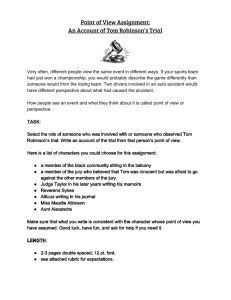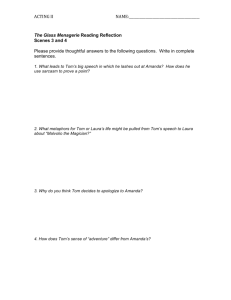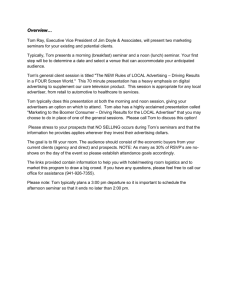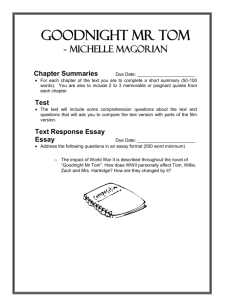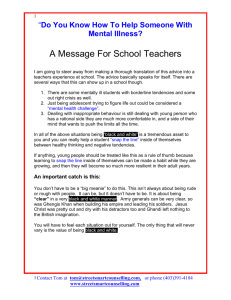ASHA seminar - University of Massachusetts Amherst
advertisement
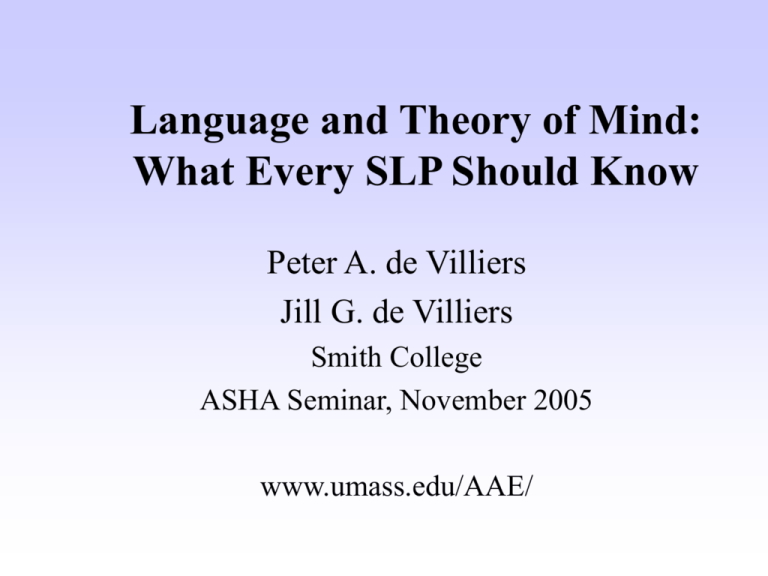
Language and Theory of Mind: What Every SLP Should Know Peter A. de Villiers Jill G. de Villiers Smith College ASHA Seminar, November 2005 www.umass.edu/AAE/ Thanks to • Bob Hoffmeister Boston University • Brenda Schick University of Colorado • Elaine Gale University of Colorado • Jennie Pyers Smith College • Roberta Giordano Smith College • Jennifer Friedman Smith College • Barbara Zurer Pearson University of Massachusetts • Francis Burns University of Massachusetts A host of Smith College undergraduate research assistants. The folks at The Psychological Corporation for the SLI data. And a series of NIDCD grants to Smith College and U Mass over the last 10 years. Introduction: What is it to have a Theory of Mind? • Being able to infer and use information from other people about their emotions, desires, intentions, beliefs, knowledge. • Understanding that their behavior is a reaction not just to the environment, but to those mental states. • A “theory” because the child infers people’s mental states from their behavior and uses those concepts to predict and explain behavior (Astington & Gopnik, 1991) Stimulus Mental State Response Why have a Theory of Mind? • Important for social interaction: to explain and predict others’ actions. • Important for communication: to assess our listener’s knowledge state, to tailor messages. • Important for narrative: to understand motives, intentions, desires, beliefs of characters -- what Bruner (1986) called the “landscape of consciousness”. • Therefore crucial for literacy and success at school. ToM and Social Outcomes • Lalonde and Chandler (1995) found that ToM was related to social skills that arguably involve mental states (e.g., following rules in simple games without being reminded) but was not related to social skills that only involve routine social conventions (e.g., saying “thank you”). • Jenkins and Astington (2000) report a significant impact of ToM understanding on children’s success at complex pretend play, particularly joint role taking and explicit communication of roles. • Astington and Pelletier (2003) found that children’s ToM understanding accounted for unique variance in a teacher rating of the children’s social competence, even after accounting for age and language ability. There was no evidence of the reverse effect. A Quick Tour of the Territory: Normal Theory of Mind Development from Infancy to Kindergarten At first… • Infants are sensitive to eye-gaze as a signal of what someone is interested in. • They follow eye-gaze to share attention on an object or event. • As toddlers, they come to use eye-gaze and pointing as signals of what a person is referring to by a word. • So shared attention is a basic prerequisite for early word learning. In addition… • Infants seem to understand that behavior of humans is intentional. • Woodward’s work (Woodward, 1998) shows that babies expect a hand that reaches for object A will continue to reach for A when objects are switched. They don’t have the same expectation for a robotic stick. A B Intentions • The young child’s ability to read both action and communicative intentions is also critical for word learning. • Bloom (2003) and Tomasello (2001) both show that in learning words, toddlers are highly attentive to whether a person’s intention was achieved. And emotions… • Infants are sensitive to emotional expressions, and from the first months are disturbed by negative or unresponsive emotional expressions. • They expect “happy” voices to come from “happy” expressions” and sad voices from sad faces, by the end of the first year. By two years… • Children seem to understand that desires are individual: they may prefer crackers, but an adult might like broccoli better. • Having seen this preference, they hand broccoli but not crackers to the adult when asked “can I have some?” • This shows they are beginning to understand different desires. Pretense • In the third year of life children begin to distinguish between the world of pretense and the real world. • For example, pretend cereal is poured from a familiar cereal box into one of two distinctively different bowls. The child is asked to feed a puppet his cereal. • Which bowl does the child use? Two-and-a-half year olds reliably choose the one that has pretend cereal in it, not the one that is still “empty”. Labeling emotions • By three, children know the words for and can label simple emotional expressions. • And they can predict what emotion someone will have if they experience a commonplace event e.g. drop their ice-cream, or get a new toy. • They also understand that emotions relate to people’s desires. We are happy when we get what we want, and sad when we don’t. Beliefs • By three-and-a-half, children can understand that someone will act according to his beliefs. • For example, child is asked which of two closed boxes a character should look in to find an object. Then the child is told the characters thinks it’s in the other box. • Children can predict that the character will look in the box he thinks the object is in. By three and a half… • Children understand that if one character has seen in a box, and another character has not seen in the box, they have different knowledge. • They also understand that if someone has left a room, that person may need to be shown where something has been placed in their absence. • In other words, that seeing leads to knowing. False Beliefs A critical development in ToM comes: • When the child can differentiate his/her own mental states from those of others (i.e., can think about other people’s thoughts). • Is aware that people can differ in their beliefs and knowledge, and comes to understand that his/her own or other people’s beliefs may be false. • Can represent the contents of mental states, the truth or falsity of that content in relation to shared “reality”, and different people’s point of view on events. Unseen change of location • A character puts an object in one of two or three possible locations and then leaves the scene. While he is away, a second character moves the object to a new location. The first character then returns to the scene and wants the object. Following memory check questions, the child is asked where the character will look (or “first look”) for the object. • The 3 year old says the character will look where the object now is. • The 4 year old says he will look where he last saw it. Unexpected Contents • In unexpected-contents tasks, the child is shown a familiar container such as an M&M candy box, an egg carton, or a CRAYOLA crayon box, that leads them to expect particular contents. • However, when they look inside, the box turns out to contain something unexpected -- for example, a plastic spoon in the crayon box. The box is then closed up again and the child is asked either what they thought (or “first thought”) was in the box before they looked inside or what a friend would think was in the box before they looked inside. • The 3-year-old says he will think there’s a spoon in the box. • The 4-year-old says he will think there are crayons in the box. Some common real-life scenarios that involve theory of mind • • • • Hide-and-seek Explanation of mistaken actions Predicting what characters in a story will do Understanding familiar nursery tales - they often depend on false appearance, trickery, deception: Cinderella, Sleeping Beauty, Little Red Riding Hood. Steps in Theory of Mind Understanding false beliefs; emotions, desires based on belief 4-5 yrs Understanding the relationship of seeing to knowledge; conflicting emotions 3.5-4 yrs Understanding desires; simple “scripted” emotions; pretence 2.5-3.5 yrs Basic ToMM: shared attention, directed eye gaze, monitoring intent of others. 9mos-2.5 yrs Theories of ToM change • Social-cognitive development comes first, largely independent of language acquisition, and provides the conceptual base onto which language maps (e.g. Piaget). – Innate, maturing ToM mechanism (Leslie, 1994) – Simulation Theory (Harris, 1988) (= empathy) – Theory Theory (Gopnik & Astington, 1991) (child as little scientist or anthropologist) • All these place little weight on a causal role for language, except as a source of evidence. Language-as-Key • Semantic/Pragmatic Theory. (e.g. Astington, 2001; Bartsch & Wellman,1995; Dunn, 2005; Harris, 1996; Peterson & Siegal, 1995, 1999) – ToM is facilitated by: • -- references to mental states in explanations of behavior (focus on mental causes, labels for concepts) • -- conversational dialogue (reading communicative intent, presuppositions, and state of knowledge) • Syntactic Theory. (e.g. J. de Villiers, 1995; Tager-Flusberg, 2002) • Acquisition of the underlying syntactic structure of complement clauses with verbs of communication (“say”, “tell”) enable the representation of false beliefs. What special syntax might be involved? • Verbs of mental state uniquely take complements, for example, Bill thought he caught a unicorn • Notice the complement clause “ he caught a unicorn” is false, but the whole sentence is not false. This is unlike e.g. an adjunct • Bill left then he caught a unicorn in which if the adjunct clause is false, the whole is also false. What do complements allow? • They allow the representation of truth and falsity in a world in someone else’s mind that is distinct from the world as represented in our own mind. • From that representation, reasoning can proceed about what the person might do, based on such a representation, or to explain what they have done. Two Roles for Language in Theory of Mind Development: • Language input to the child: – Conversational role and points of view – Language about mental states • Language skills of the child: – Labels for mental concepts – Pragmatic skills – Syntax for representing mental state contents Test for the processing of False Complement Clauses with Verbs of Communication: The woman said that the girl had a bug in her hair (picture of woman pointing at child’s hair). But it was really a leaf (picture of the child’s head showing a leaf). What did she say the girl had (t) in her hair? Claim: • To get the right answer to the wh-question the child has to know that the clause is embedded. • The question is embedded under the scope of BOTH verbs • Not just what did the girl have, but what the woman said the girl had. • 3 year olds answer “ a leaf” = what the girl had • 4-5 year olds answer “a bug”. What Evidence on Role of Input? • Dunn (1994, 2005) noted a correlation between aspects of family conversation and the child’s performance on measures of emotion understanding and false belief reasoning. • Families that talked a lot about the psychological causes of behavior, especially emotions, desires, and states of knowledge/ignorance, had children who were more likely to pass tests of ToM. • But could the child be leading the caregiver? The Role of the Language Input (Ruffman et al., 2002, 2003) Ruffman et al assessed: • Children’s language competence (CELF) • Their Theory of Mind skills on standard tasks • The mother’s use of mental state-talk during discussion with the child of the characters in a picture book. • Each of these three measures was taken at three different time points (t1, t2 and t3) over the course of approximately 1 year. • Mothers’ mental state language during the picture task (at t1 and t2) predicted children’s later ToM performance (at t2 and t3) even with children’s prior language ability and ToM performance (at t1 or t2) partialled out. So clearly, language input has an effect. Mind-Mindedness • Meins et al (2002) found the best predictor of their children’s later ToM was the mother’s tendency to talk about her infant at six months in mentalistic terms. • They called this “maternal mind-mindedness”, e.g. “He wants me to do that again.” “She thinks that’s funny.” • Mothers who use a lot of mental descriptions rather than trait or behavioral descriptions had children who learned ToM faster. Which children have trouble with ToM? 1) Children with autism. The idea of “Theory of Mind” had a central focus on the problems that are shown in autism: • Early ToM: marked problems in shared attention, lack of following eye gaze and pointing, lack of pretend play, difficulty responding to emotions. • Late ToM: even in higher functioning children, a failure to pass “false belief tasks”. • How are these connected to the language problems that also characterize children with autism? Other groups 2) Language delayed deaf children also show marked problems in late ToM: failing to pass “false belief” tasks. • However, there are no reports of special difficulties with early ToM: shared attention, emotional understanding, gaze following. 3) Specific language impaired (SLI) children also fail false belief tasks, but early ToM may be spared. • It should be noted that relatively little work has explored these questions of how early ToM develops in these two groups. Is a child’s language delay implicated in delays in false belief understanding? What role is played by a child’s own language skills? • • • • Longitudinal studies of preschoolers Training studies Longitudinal study of autistic children Studies of specific language impaired (SLI) children • Studies of deaf children -- oral and signing Longitudinal Studies (Astington & Jenkins, 1999; J. de Villiers & Pyers, 2002) • Tested language acquisition and development of false belief understanding between age 3 and 4 in preschoolers. • Language predicted later false belief reasoning, not vice versa. • Processing of false complement clauses with verbs of communication was a better predictor of later theory of mind development than were other measures of general language skills (e.g. MLU). • (“She said that she was reading a book, but it was really a comic.” “What did she say she was reading?”) Training studies • Two separate training studies (Hale and Tager-Flusberg, 2002; Lohmann & Tomasello, 2003) have shown that teaching the syntactic structures relevant for language about the mind can have a significant effect on children’s performance on false belief tasks. • The studies used communication verbs (e.g. say, tell) which have the same syntax as verbs like think, believe in that they take embedded complement clauses: “She said that it was an apple, but it was really an orange”. • Training on these false communication complement structures accelerated later false belief reasoning more than direct training on the standard false belief tasks or on appearance/reality tasks themselves. • Training on other complex sentence forms, such as relative clauses had no effect on theory of mind development. Longitudinal Study of Autistic Children (Tager-Flusberg & Josephs, 2005) • Although most autistic children show extremely deficient understanding of mental states, especially of cognitions, some high functioning autistic adolescents do manage to pass standard tests of false belief reasoning. • Longitudinal study of such children show that comprehension of false complement clauses with verbs of communication is the strongest predictor of their mastery of false belief reasoning (even when controlling for age and IQ). • Acquisition of false complement clauses with say and tell may allow them to bootstrap their reasoning about false beliefs, even when they continue to have pervasive problems in reading complex emotions, desires, etc. • Tager-Flusberg & Josephs suggest that the children use explicit language about the tasks as a means of reasoning. Study of SLI Children (P. de Villiers, Burns, & Pearson, 2002) • Unlike autistic children, SLI children are not intellectually impaired or socially withdrawn. • Their understanding of and reference to simple emotions and desires seems unimpaired in narratives, BUT • They are impaired relative to age matched typicallydeveloping peers in their understanding of false beliefs and references to cognitive states in narrative. • AND their understanding of characters’ false beliefs is predicted by their understanding of false complement clauses as well as by their ability to take a speaker’s perspective in a communicative role taking task. Subject Sample • Criteria for inclusion (clinical status): – All normal range IQ. – Language impaired: – a. tested as high or highest risk on DELV Diagnostic Screener. – b. Testing clinicians and school said they were language impaired and they were receiving language intervention services. – Typically developing: – a. tested as lowest risk on DELV Diagnostic Screener. – b. Testing clinicians and schools said they were not language impaired. Subject Sample 4 5 6 7to9 Total LI 16 29 33 27 105 TD 45 42 69 30 186 LI 17 24 23 23 87 TD 33 42 42 34 151 111 137 167 114 529 AAE MAE Total Subject Sample Girls Boys Mean Age % LI Mean PED AAE 146 145 6.16 36.1% 2.89 MAE 115 123 6.29 36.3% 3.14* * = p<.05 ToM Assessment • The children told two picture sequence cued short narratives, based on the standard unseen object location change scenarios. • After each narrative they were asked two ToM probe questions: – To describe the events in the picture containing a character with a thought bubble (thought bubble description) (Wellman, Hollander & Schulte, 1996). – To explain the characters’ actions of looking for the object in the wrong place based on their false belief about its location (false belief explanation) (Bartsch & Wellman, 1989; J. de Villiers & Pyers, 2002). Language Assessment • Non-word Repetition (DELV-Screener) (0-6) – Language processing and verbal memory • Verb Contrasts (DELV-CR) (0-10) – Verb vocabulary (no mental state verbs) • Communicative Role Taking (DELV-CR) (0-4) – Reading speech act intentions • Morphosyntax Production (DELV-Screener) (0-7) – Dialect neutral • Relative Clause Processing (DELV-CR) (0-1) – Wh extraction out of a complex sentence with a relative clause • False Complement Clause Processing (“say”) (DELV-CR) (0-1) – Wh extraction out of a complex sentence with a false complement Effect of Language Impairment on False Belief Explanations False Belief Reasoning and Clinical Status 1.6 1.4 Average Score 1.2 1.0 LI TD 0.8 0.6 0.4 0.2 0.0 4 6 5 Age 8 Results -- Regressions Predicting False Belief Explanations Background Measures (R2=.136): • Age (p<.001) • PED (non-significant) Language Measures (∆R2=.098): • Verb Vocabulary (p<.01) • Communicative Role Taking (p<.05) • False “Say” Complement (p<.01) • • • Non-word Repetition (non-sig) Morphosyntax (non-sig) Relative Clause (non-sig) Oral and Signing Deaf Children • • • • Deaf children provide another critical test of the causal role of language in Theory of Mind development. Many deaf children have significantly delayed language acquisition, but they have age-appropriate non-verbal intelligence and active sociability. A subgroup of deaf children who have deaf parents (DoD) are exposed to a full language from birth in the form of a natural sign language, so their language acquisition follows the normal timetable. They therefore provide a control for any effects of deafness per se. If language acquisition plays a central causal role in Theory of Mind development, then deaf children with delayed language will experience corresponding delays in their understanding and reasoning about mental states. But deaf children of deaf parents who have native sign language will not be at all delayed in ToM. NIDCD Study of Language and ToM in Deaf Children (P. de Villiers, 2005; Schick, de Villiers, de Villiers, & Hoffmeister (under review) 4 5 6 7 Total Hearing Controls ASL DoD ASL DoH 20 11 11 11 14 11 13 49 8 10 10 13 41 Oral DoH 18 27 17 24 86 42 Theory of Mind Tasks • Standard Verbal False Belief (FB) Reasoning: – 3 unseen object location change stories – 2 unexpected contents containers asking about both own and others’ initial FB • Two Low Verbal ToM Tasks: – Sticker-hiding game -- seeing = knowing (Gale et al, 1996; de Villiers & de Villiers, 2000) – Surprise Face game -- what face to put on a character based on their expectations (de Villiers & de Villiers, 2000) Key Findings: Group Comparisons • Language delayed deaf children (ASL-DoH and Oral) were significantly delayed in ToM reasoning relative to children with normal language acquisition (Hearing and ASL-DoD). (cf. also Jackson, 2001; Peterson & Siegal, 1995,1999, 2000; Russell et al, 1998; Steeds et al, 1997) • Language delayed deaf children were delayed in ToM reasoning on both high verbal standard tasks and low verbal tasks -- so it is not just the language demands of the tasks (cf. also Figueras-Costas & Harris, 2001; Woolfe, Want & Siegal, 2002). • ASL-DoD children performed the same as Hearing controls at ages 4, 5, and 6 years on both high verbal and low verbal ToM tasks (cf. also Courtin, 2000; Peterson & Siegel, 1997, 1999; Woolfe et al, 2002). Deaf and hearing children across ages: verbal tasks Verbal False Belief Reasoning Percent of Group Passing 100 90 80 70 Hearing ASLDoD ASLDoH Oral 60 50 40 30 20 10 0 4 5 6 Age 7 Deaf and hearing children across ages: low-verbal tasks Low-Verbal ToM Tasks Passed 2 Average Number of Tasks 1.5 Hearing ASLDoD ASLDoH Oral 1 0.5 0 4 5 6 Age 7 Key Findings: Significant Predictors of ToM • Verbal false belief reasoning scores of the deaf children were independently predicted by Age, Receptive Vocabulary, and Processing of False Complement Clauses with verbs of Communication. • Hearing Loss, Non-verbal IQ, Sequence Memory, and General Syntax Comprehension were not significant independent predictors. • Passing the Low Verbal Tasks was independently predicted by Age and Processing of False Complement Clauses with Verbs of Communication. • Hearing Loss, Non-verbal IQ, Sequence Memory, General Syntax Comprehension and Receptive Vocabulary were not significant independent predictors. • The same predictors were found for both the Oral Deaf children and the ASL children. What ToM Reasoning can Deaf Child do without Complex Language? • Deaf children are not as impaired in ToM as autistic children. • They are close to age level on interpretation of emotions based on situations and desires (but not knowledge and belief). • They are adept at deception games (e.g., the penny in the hand game) • Complex language (embedded complement clauses) seems to be required for the explicit representation of the content of false beliefs and states of knowledge. Input Language about the Mind to Autistic and Deaf Children • Tager-Flusberg (2003): mother - autistic child conversations are selectively devoid of reference to mental states, especially cognitions, by either the mother or the child. • Moeller (2002): Mother’s signed use of mental state expressions (desires and cognitions) in describing events to their signing deaf children is predictive of the children’s ToM reasoning, independent of the children’s own language skills. ToM as prerequisite for other language skills • Sharing attention and understanding referential intent drives word learning. • Tailoring language by taking into account what one’s listener knows and doesn’t know is crucial for effective conversation. (Aspergers, verbal Autistics don’t do it -- they tend to say too much or too little) • Narrative -- Bruner’s (1986) “landscape of consciousness” vs the “landscape of action”. • Who knows what and knowing what to call a thing (referential opacity). Language and ToM are reciprocally related: • Early ToM drives language development -toddlers reading communicative intentions. • Around age 3 to 4 language acquisition (of mental state vocabulary and complement clauses) drives ToM development. Both the input and the child’s own language seem to be important. • Both ToM and the language of the mind then drive later development of discourse and communication skills. Implications for Assessment and Intervention • You can’t teach language without shared attention and children’s reading of intention. • The research on input shows that language about mental states is most effective in facilitating ToM development when it is provided in the context of a shared communicative task -- in joint book reading, or in shared role play. • It is elaborated expressions of cognitive states that are most important, with the contents and causes of the mental states expressed. Just increasing the use of words for mental states is not as effective. • Complement clauses need to be mastered and are best taught with communication verbs where the truth and falsity of the content is more explicit (see training studies). Key Readings • • • • • • • • • • Astington, J. & Baird, J. (Eds.), Why language matters for Theory of Mind. Oxford University Press, 2005. Bartsch, K. & Wellman, H. Children talk about the mind. Oxford University Press, 1995. de Villiers, J. & de Villiers, P. Language for thought: Coming to understand false beliefs. In D. Gentner & S. Goldin-Meadow (Eds.), Language in mind: Advances in the study of language and thought. MIT Press, 2003. de Villiers, J. & Pyers, J. Complements to cognition: A longitudinal study of the relationship between complex syntax and false belief understanding. Cognitive Development, 2002, 17, 1037-1060. de Villiers, P., Burns, F. & Pearson, B. The role of language in the Theory of Mind development of language-impaired children: Complementing theories. In B. Beachley, A. Brown, & F. Conlin (Eds.), Proceedings of the 27th Annual Boston University Conference on Language Development. Pp. 232242. Cascadilla Press, 2003. Hale, C. & Tager-Flusberg, H. The influence of language on theory of mind: A training study. Developmental Science, 2003, 6, 346-359. Lohmann, H. & Tomasello, M. The role of language in the development of false belief understanding: A training study. Child Development, 74, 1130-1144. Peterson, C. & Siegal, M. Insights into theory of mind from deafness and autism. Mind & Language, 2000, 15, 123-145. Ruffman, T., Slade, L, & Crowe, E. The relationship between children’s and mothers’ mental state language and theory-of-mind understanding. Child Development, 2002, 73, 734-751. Tager-Flusberg, H. Language and understanding minds: Connections in autism. In S. Baron-Cohen, H. Tager-Flusberg, & D. Cohen (Eds.), Understanding other minds: Perspectives from developmental cognitive neuroscience. Oxford University Press, 2000.

